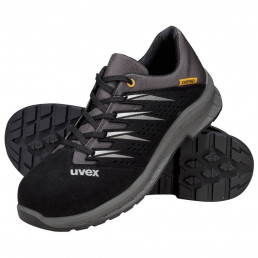Every day, over 1,000 workplace accidents caused by slipping, tripping or falling are reported in Germany. What are the effects of STF accidents and how can they be avoided? In this blog article, we answer these questions and explain how we test the slip resistance of safety and work shoes.
STF accidents and their consequences
Every two minutes, someone slips, trips or falls at work. One minute, you’re going about your work as usual, the next, you trip or slip. It happens so fast that you’re not usually able to react. What to bystanders often looks funny and doesn’t appear to be serious may actually result in serious health problems.
Ankle injuries – strains and torn ligaments – are common. Falling or slipping may often result in broken bones. Depending on the severity of the fall, it may even cause concussion. All of these injuries result in several weeks of absence from work and can lead to long-term health problems. Almost 5,000 accidents per year are so serious that the victim receives an employers’ liability insurance association pension due to permanent damage to health.
Anyone younger who thinks that these hazards don’t affect them is wrong. STF accidents aren’t suffered only by older generations – 20% of victims are aged between 20 and 45. No one is safe from slipping, tripping or falling. Hazards that could cause STF accidents are lurking in every working environment:
- slippery or uneven floors
- cable runs on the ground
- abandoned objects
- stairs
Stairs pose the greatest danger: according to the German Federal Statistical Office, more people die as a result of falling on stairs than in motorbike accidents.
You can help reduce hazards that may cause STF accidents by keeping your workplace tidy – but not every cause can be eliminated. You can’t avoid using stairs or walking over uneven floors. But wearing the right shoes can help significantly when it comes to avoiding slip-related accidents.

Slip-resistant work shoes
Wear slip-resistant shoes at work to prevent STF accidents – the right footwear can save lives.
In accordance with DIN EN ISO 13287, the slip resistance of our uvex safety and work shoes is tested in a machine-based testing procedure
on two different types of flooring and in two different positions. In this process, the shoe is inserted into the testing machine and pushed over the surface, which has been coated with lubricant. The test measures the resulting frictional force between the shoe and the surface.
It is carried out once with the entire sole of the footwear in contact with the surface, and a second time with only the heel area of the shoe in contact with the surface – this simulates the position of the foot when the heel comes up during the natural rolling movement of walking.
In order to be able to compare the measurements, the coefficient of friction is calculated by dividing the frictional force by the vertical force with which the shoe is pressed onto the surface.
Coefficient of friction = frictional force / vertical force
A coefficient of friction that must be achieved as a minimum has been calculated for each floor condition and test condition. Our uvex safety or professional footwear only receives the appropriate certification if this is achieved in the test.
-
SRA certification
The shoe receives SRA certification if it does not fall below the specified coefficients of friction during the test on ceramic tiles that have been coated with detergent solution (sodium lauryl sulphate solution).
-
SRB certification
If the safety shoe passes the test on steel floors with glycerine, it receives the SRB certification.
-
SRC slip resistance
SRC certifies safety and work shoes that have passed the test on ceramic tiles with sodium lauryl sulphate solution as well as on steel floors with glycerine.
Therefore, when buying your non-slip safety or work shoes, look for the appropriate certification to ensure that you are getting the non-slip resistance required for your workplace.
Sources: https://www.vbg.de/